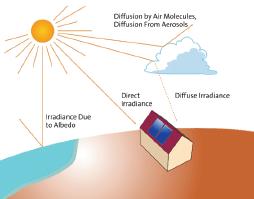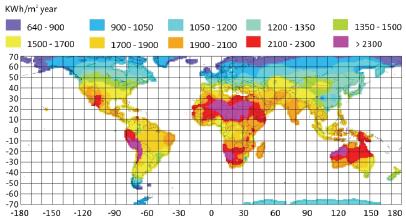
4 minute read
Introduction
This publication outlines the processes required to design and install copper solar thermal installations. It is not intended to be a designer’s manual nor to be an alternative to an approved training course run by a recognised awarding body, e.g. City and Guilds, BPEC.
Designers and installers of solar thermal hot water systems must have appropriate qualifications and have undergone suitable training.
K C m a W kWh J gtoe
Degrees Kelvin (temperature scale) Degrees Celsius (temperature scale) metres annum (year) Watts kilo W att hours Joules giga-tonnes of oil equivalent
The Sun as a Source of Energy
Primary energy sources can be classified as renewable and non-renewable sources. These primary sources are transformed into the intermediate sources, chiefly electricity and fuels. The global yield of the transformation of energy is very low, in the order of 2.5%. This means that 97.5% of primary energy is not utilised by man but is merely withdrawn from nature.
World annual energy consumption is equal to 9gtoe (giga-tonnes of oil equivalent). We have available to us, from coal, 800gtoe and from solar radiation 25,000gtoe. So, it makes very good sense to use the available solar energy, and save precious non-renewable resources ( see Figure 1).
The sun is an inexhaustible source of energy (by human standards). It can be likened to an integral radiator (black body) at a temperature of 5777K (1 degree Kelvin = I degree Celsius, 0ºC = 273K) which sends us 1367 W/m2 of energy.
The relative movement of the earth with respect to the sun, and to itself, explains the positions the sun takes for a given observer on earth. To properly position a solar installation, it is necessary to know the terminology of the most important angles for the position of the sun and the collectors. The sun is always moving in relation to the collector, both by azimuth and altitude. In general, the optimum position for irradiation is facing due south and pitched up at the same angle as the local latitude. However, where the sun's energy is dispersed through clouds, the angle of pitch can be reduced without significant loss.
The solar radiation crosses the atmosphere and on its path undergoes changes in intensity and direction as a result of its interaction with atmospheric components. The main interaction is of two types: absorption and diffusion.
Absorption
Fair-sized (in relation to the wavelength of solar radiation) atmospheric components can totally absorb the radiation beamed at them, thereby reducing the radiation intensity . On the other hand, the internal energy, and as a result the temperature of the atmospheric components, increases and they are converted into long wavelength radiation emitters which impact, in part on the earth, contributing to the resulting diffuse radiation.

Figure 1: World primary energy reserves
Diffusion
Components of smaller size (e.g. air molecules) produce variations in the direction of the radiation beam, thereby causing dispersion and giving rise to diffuse radiation of a short wavelength which reaches us from any point of the celestial sphere ( see Figure.2).
From what we have seen, it is clear that solar radiation which reaches a collector has the following components: • the direct (beam) component which comes from the solar 'disc' without change in direction • the diffuse component which comes from the entire celestial sphere • the reflected component which comes from the ground as a result of the reflection of direct and diffuse components by the ground.


Figure 2: Interaction between solar radiation and the earth's atmosphere
(Note: Solar thermal installations without ‘concentration’ make use of the direct, diffuse and reflected components of solar radiation. Models with ‘concentration’ make use only of the direct component).
On clear days there are very high levels of irradiance which can be in the order of 800 to 1000W/m 2, , while on completely overcast days only 200W/m 2 or less are obtained. Seasons can also have an effect on irradiance levels. Solar irradiance is the power of solar radiation per unit surface area, expressed in W/m 2 . Solar irradiation is the energy of solar radiation over a given period of time, expressed in J/m 2 or in kWh/m 2 . On a good summer day, UK irradiation levels can go up to 6kWh/m 2 (see Figure 3).
The available solar energy differs from one geographic area to another and there are also variations throughout the year. In desert areas close to the equator, annual irradiation levels of up to 2200kWh/m 2 /a are recorded. This is almost double the annual average obtained per sq.m in Central Europe. In the UK the values vary from 850 to 1200kWh/m 2 /a.
Figure 3: World annual average radiation








